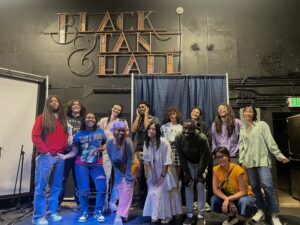We are lucky to work closely with an incredible network of PB researchers and research teams in North America. We’ve decided to launch a PB Research blog series, so that our readers and supporters can learn more about what’s happening in the world of PB research!
First up – Thea Crum, Director of the Neighborhoods Initiative at the Great Cities Institute (GCI) at University of Illinois-Chicago, member of the lead research team for PB Chicago, and board member for the North American PB Research Board. We talked to Thea about her research at the GCI, which recently released their evaluation report for PB Chicago Cycle 2.
Madeleine Pape (PBP): Thea, where do you fit in the world of PB research?
Thea: We conduct research and evaluation on PB Chicago. The goal of the research is to increase public control of public money through the documentation and evaluation of the PB processes in Chicago. The research examines who does and does not participate in the Chicago PB process, why people participate, how the design of different outreach processes influences participation, how PB impacts relationships between elected officials and residents, and what skills, beliefs and attitudes participants learn and adopt as a result of the process.
PBP: What are the findings in your most recent publication on PB?
Thea: Our most recent publication was the report on the 2013-2014 PB Chicago cycle. The key findings include:
- More people of color, low-income individuals, and youth participated compared to the previous year’s cycle (2012-2013).
- Targeting youth at assemblies held in schools during school hours increased their engagement and turnout.
- Over $1.6 million in additional funding beyond the commitment of aldermanic menu money was leveraged for community projects identified through the PB process.
- PB is becoming institutionalized into the City of Chicago government.
Additional findings from the second year of PB Chicago are similar to and reinforce findings from the 2012-2013 cycle including:
- Participation by people of color and other historically underrepresented residents was generally consistent with the participation of these groups in local elections.
- By engaging and participating in PB, participants learned about the needs of their ward, the interests of their neighbors, and the city budgeting process.
PBP: What are the biggest challenges you’ve encountered in researching PB and how have you overcome them?
Thea: One of the biggest challenges has been finding the most appropriate comparative baseline data to evaluate how inclusive the PB process has been. We currently use two main sources: the 2010 Census and the 2008-2012 American Community Survey (ACS) five-year estimates to provide a point of comparison and to measure the extent to which PB participants were “representative” of a ward’s population. To provide a more reasonable point of comparison for measuring representativeness, we also include an estimate of 2010 local election turnout by race and age for each ward.
There are several problems with using census data and extrapolated local voter turnout rates for comparative purposes. Therefore, we present different data to provide points of comparison but caution readers against drawing strong conclusions from it.
PBP: What has your research uncovered about ways to improve PB?
Thea: One of the most important things the research has demonstrated is the importance of building the PB process around existing community assets and civic infrastructure as well as how critical traditional community organizing is for engaging more marginalized populations. Many of our communities have a wealth of institutions, organizations and associations that all engage with community members in a variety of different ways. When PB incorporates these existing networks into the process it simultaneously strengthens the PB process and the fabric of the community overall.
PBP: What do you enjoy most about engaging with PB in your work?
Thea: PB is fascinating and inspiring in so many ways. It is a very dynamic process. I really enjoy seeing how each community modifies and changes the process to best fit to their local conditions and goals. People really take ownership of the process and make it their own. I also enjoy observing how people from different backgrounds learn not only how to work together to better their community but also about each other and have fun in the process. In addition, many of the residents, alderman and their staff and organizations also use the data provided by the research to improve their processes. It is exciting to see your work as a researcher have an immediate impact in a community.





